To view more Articles, please visit our Leads 2 Business Blog.
If you are interested in becoming one of our subscribers, please visit Leads 2 Business.
To view notes with screenshots on how to use our website, please visit Leads 2 Business Wiki.
To view more Articles, please visit our Leads 2 Business Blog.
If you are interested in becoming one of our subscribers, please visit Leads 2 Business.
To view notes with screenshots on how to use our website, please visit Leads 2 Business Wiki.
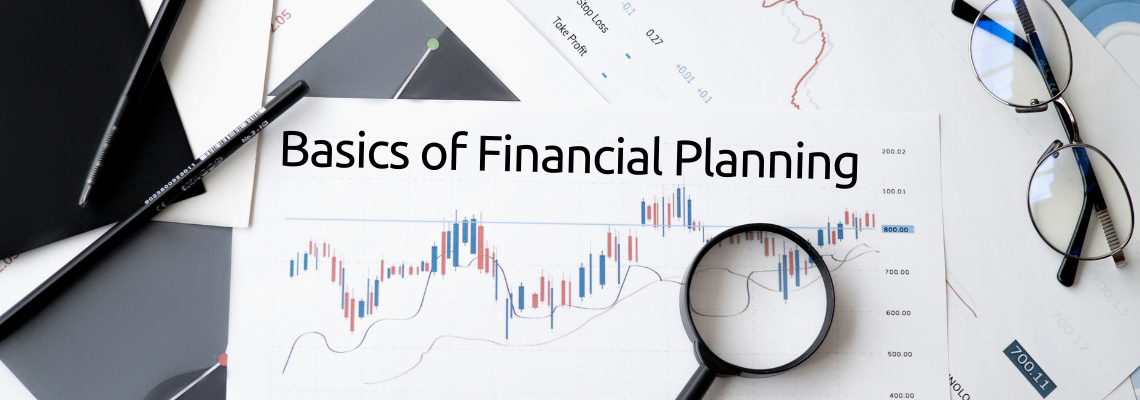
What is financial planning? For anyone who needs a quick explanation, they could simply open google and do a quick search. A few line items down, Google would pop something out like: “A step-by-step approach to meet one’s life goals”, or “A comprehensive picture of your current finances”, or my favourite, “Financial planning … it’s unlikely that your financial position will remain the same throughout your life”. It can all seem a bit confusing, especially to those who might not have a financial background. Simply put, financial planning is comparing your business’s current financial situation to your long term financial goals. This is so vitally important, not just to businesses but to every single individual in their personal capacity as well. Failure to do even a basic financial plan could lead to cash flow problems, failure to meet tax and other compulsory monetary demands, overspending and ultimately failure to reach your business and personal goals. So let us look at what a basic financial plan would entail.
1. Understand your current financial position
This entails making a list of assets, debts, income and expenses. Once your lists are prepared, compare your debts to your assets and your expenses to your income. If your debts are greater than your assets, this means that your assets are insufficient to pay your debts. Should your expenses be greater than your income, this could signify cash flow problems. This overall picture is the foundation you will use to create your financial plan.
2. Set your goals
Once we know what our financial picture looks like, we will set our financial goals. Each person and organisation will have their own unique set of goals based on the specific financial picture. Your goals set should be realistic and should be set for both the long term and short term. Common goals would be to pay off debt, establish an emergency fund, save for retirement and plan for some downtime. Once your goals are established, you would use this in conjunction with your income and expense lists.
3. Develop a plan of action
At this point in your plan, you would know where you are financially and you know what your financial goals are. Some will be fortunate enough to be in a favourable position and could continue on their existing path without making any changes. For others, they would have realised that in order to reach their financial goals, they require a change in lifestyle or outlook. For each financial goal, you would need to think about what it would take to meet that goal. Retirement savings take decades to accumulate. Perhaps you would need to increase your savings category or deposit a lump sum into your retirement plan. For more short term goals it could just entail going through your expenses and cutting down on unnecessary costs. Budgets should be drawn up and all areas of excess spending should be curtailed. If opportunities exist for generating further income, now is the time to put that into action.
4. Review and revise your financial plan
Your financial plan should be reviewed regularly. Our financial position, the economy, the markets – these can and will change over time. In order to stay abreast of our financial situation and goals, we need to keep our financial lists updated regularly. Take time to regularly view your savings and investments to determine if they are on track for your savings goals. As your circumstances change, your financial plan should be updated. Income and expense schedules should be reviewed monthly and assets and debt schedules should be reviewed quarterly. Your personal life will change as your family grows or as you face life challenges. It is absolutely imperative that your regularly update your financial plan to keep it relevant and achievable.
Should you find your business or personal situation overwhelming or need further assistance on how to set up a financial plan, please do make an appointment to see a financial advisor or planner. These professionals will assist with wealth management and can assist with drawing up plans or investment strategies specific to your needs.
If you are interested in becoming one of our subscribers, please visit Leads 2 Business.
To view notes with screenshots on how to use our website, please visit Leads 2 Business Wiki.
To view more Featured Companies, please visit our Leads 2 Business Blog.
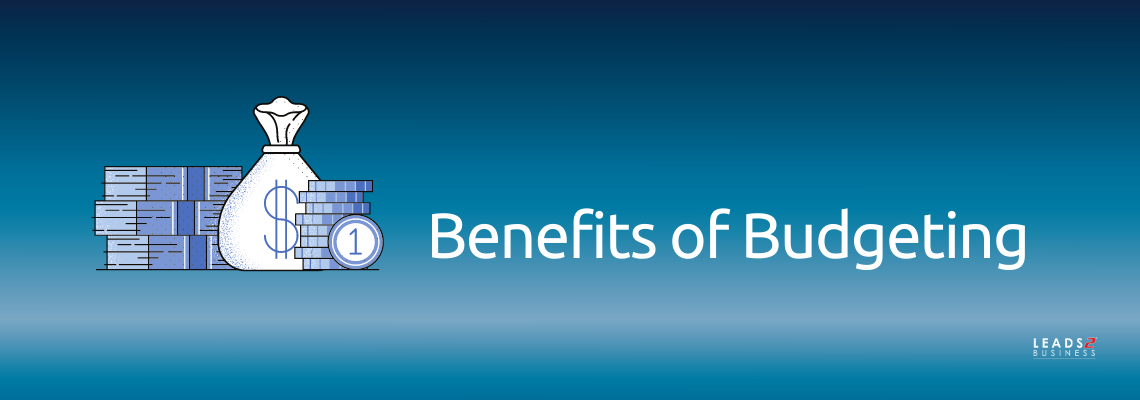
Budgeting – a word that sounds as if you’ve just stripped the fun out of life. You get your salary at the end of the month and before you have even had a chance to look at your balance you are already hearing that familiar tone on your phone letting you know that your balance is reducing, as one by one, those pesky bills are coming off. If you have not done your planning correctly, you may even feel a little stress and anxiety, hoping and praying that you have in fact got enough left over to get through the rest of the 28 days or so of the month remaining. Perhaps you are more organized than others and, even without a budget, you are confident that your income, by far, exceeds your expenses. Then you get a spontaneous urge to go on a much-needed weekend away or indulge in something a little extravagant but are unsure as to how much you actually have available as you have lost track of what is available to spend and what is still to be paid. What if I told you that this does not need to be your reality? And what if I told you that a budget needn’t be a complex schedule of reds and blacks, casts and cross casts, ticks and crosses? Below will highlight the benefits that can be enjoyed from budgeting:
A budget will help you figure out your long-term goals and help you work towards them. It may seem fun now, wandering aimlessly through life, throwing money at any pretty, shiny thing that may come your way, however, how will you afford that car you have dreamed of owning, that first down payment on your home, or that trip to Mauritius? A budget will help you keep focus and will allow you to keep track of how far you have gone and ultimately assist you in reaching your dream. You will find it much easier to turn away from that newly released Playstation when you have a goal plan set out and have given yourself a time frame for reaching that goal.
Far too many of us spend money that we don’t have all thanks to that little piece of plastic that is so easy to obtain in the form of credit. Credit spending in the country is at an all-time high with BusinessTech stating that in the second quarter of 2020 clients required around 62% of their net income to service debt every month with higher income earners requiring more of their income to service their debt. It’s a pesky reality, the more we earn, the more we spend. So how do we get around this? We create a budget but more importantly stick to it. Sure it is way more fun shamelessly going on extravagant shopping sprees than it is to crunch numbers, but in a year’s time, when appointments are being made with debt counselors, you will be guiltlessly booking that trip away knowing when you return that you will be debt-free.
If you are in your twenties or even early thirties, retirement might sound like something far too into the future to consider giving any thought or priority to. If this is your thinking, you couldn’t be more off the mark. We should all, from our very first job, be filtering a small portion of our savings into an investment, provident, or retirement account. The more years we have to invest, the greater the earnings later on. A budget will assist us in calculating the amount of money we have available, after set expenses, to invest in our retirement. In our glory years, we would all like to spend our time on golf courses and trips to the beach rather than working at a local grocery store in order to make ends meet.
Life is unpredictable and full of unexpected surprises, twists, and turns. Unfortunately, sometimes life deals us a blow and we may get laid off, get ill, and end up with exorbitant medical bills, divorce, or face death in the family. In order to account for these unfortunate realities, we should be setting money aside each month to accommodate for these unexpected bills. Ideally, each of us should have three to six months’ worth of living expenses saved in case of such emergencies. The thought could overwhelm us if one were to calculate how much that would be, so in order to break it down into more manageable terms, we should be budgeting a portion of that into our monthly costs. If we set that portion aside religiously each month, we would eventually reach this nest egg amount and could even invest it into an easy access account to earn a little bit of extra interest.
Creating and reviewing a budget will shed light on our spending habits. You may notice a trend of overspending on groceries or perhaps your clothing fund. This can challenge us to question our spending habits. Did we really need those five new shirts we purchased last month? Did we get more value for money shopping at a certain butcher across town where we have a more reasonably priced butcher closer to home? Are we being wasteful at home as far as our electricity or water consumption goes? If we create a monthly budget, we will soon become aware of the costs of our certain expenses and will help us identify very quickly where we have overspent, which will, in turn, make us more aware of our wasteful habits going forward.
I’m sure we have all been there, the month has come around and due to unexpected expenses, we are counting our rand and seeing how far it will stretch before that next payday. A number of studies have linked financial strain to mental health problems such as depression, anxiety, and substance abuse. By preparing a monthly budget we can ease some of that anxiety but seeing our overall financial picture in an organized and simplified manner. It will also help us to form a plan moving forward by putting steps into place which will make us feel in control of our financial situation and ease our stress and anxiety. Sometimes when put down on paper, things appear clearer and not as overwhelming as when they are running around in our heads.
The six points above are merely the tip of the iceberg. Keep it simple, write down your income, prioritize your expenses, include retirement, emergency contingencies, and goal savings and your balance left over will be your loose cash, to spend as you will. Use this basic method as a template, review and tweak it as your needs change and you will always be left feeling in control of your finances and ultimately be in control of your life.
To view more Articles, please visit our Leads 2 Business Blog.
If you are interested in becoming one of our subscribers, please visit Leads 2 Business.
To view notes with screenshots on how to use our website, please visit Leads 2 Business Wiki.
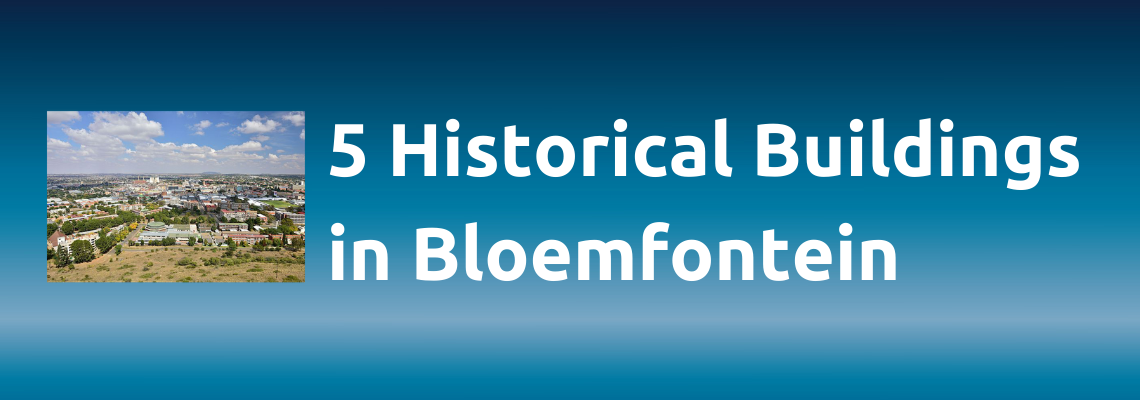
To the seasoned traveller, Bloemfontein holds a whole array of history and exciting facts. Being known as “The City of Roses” attests to the beauty the city holds as well as holding a little fame for being the birthplace of J.R.R. Tolkien, the author of The Lord of the Rings Trilogy and The Hobbit. But to the unseasoned traveller, little may be known about this city except perhaps that it is the Capital of the Free State and that it borders on the semi-arid region of the Karoo. If you’re looking for some historical insight and a city that will not disappoint, Bloemfontein is not to be missed on your next road trip. Listed below are 5 historical buildings that are an absolute must on your next South African adventure!
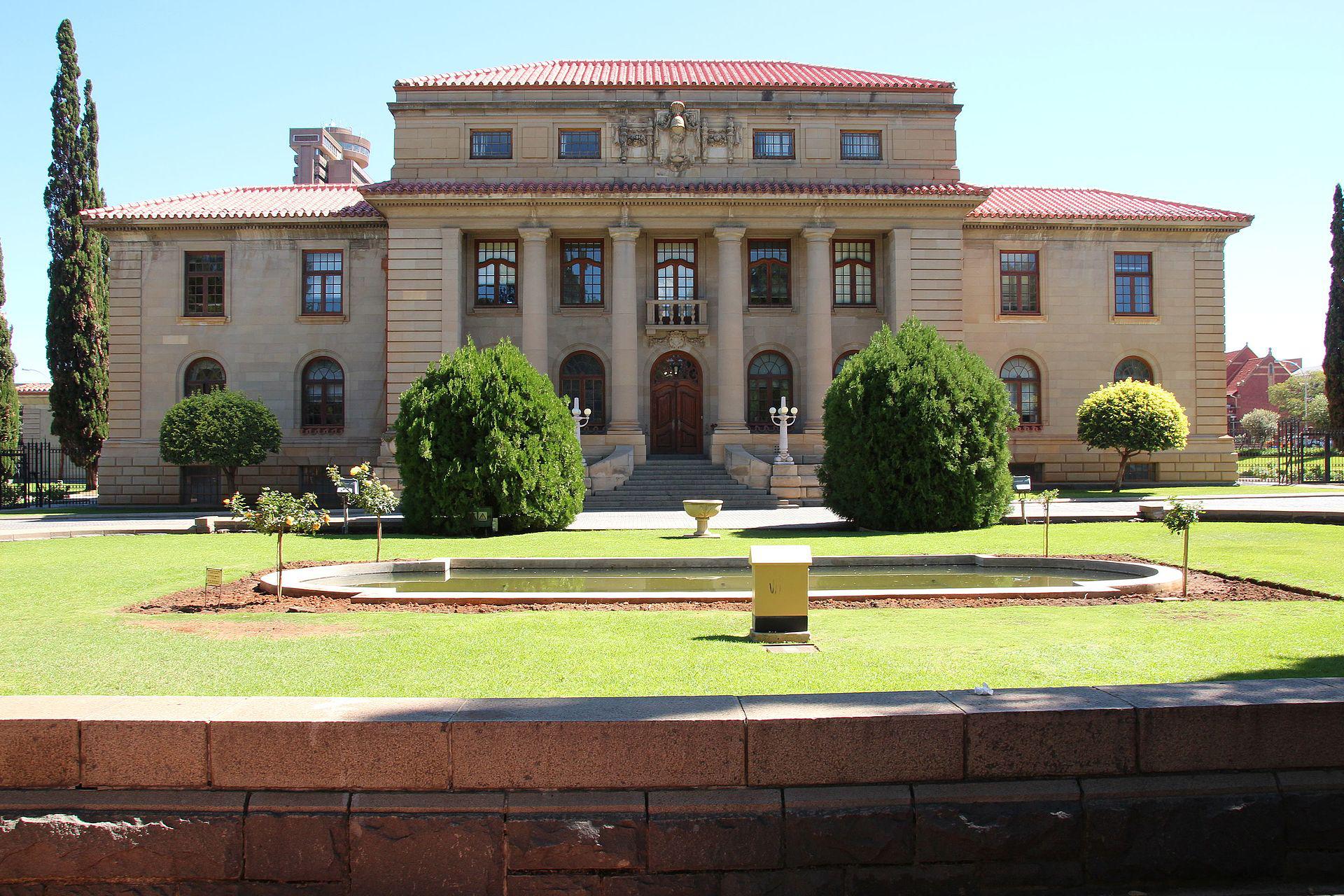
Bloemfontein is the judicial capital of South Africa. The Court of Appeal building was built in 1929 and is the highest court. The Court of Appeal is also known as the Supreme Court of Appeal where the final decisions are made. Except for the Constitutional Court, no other court rules over it.
The original building was designed in a free Renaissance style by J S Cleland, the Chief Government Architect, who was also responsible for many other major public buildings in South Africa. The oldest part was built with sandstone from Ladybrand, the newer western wing with sandstone from Ficksburg, and the latest extension with sandstone from Mookgophong in Limpopo. On each occasion, the extensions were constructed to preserve the style and appearance of the building as far as possible.
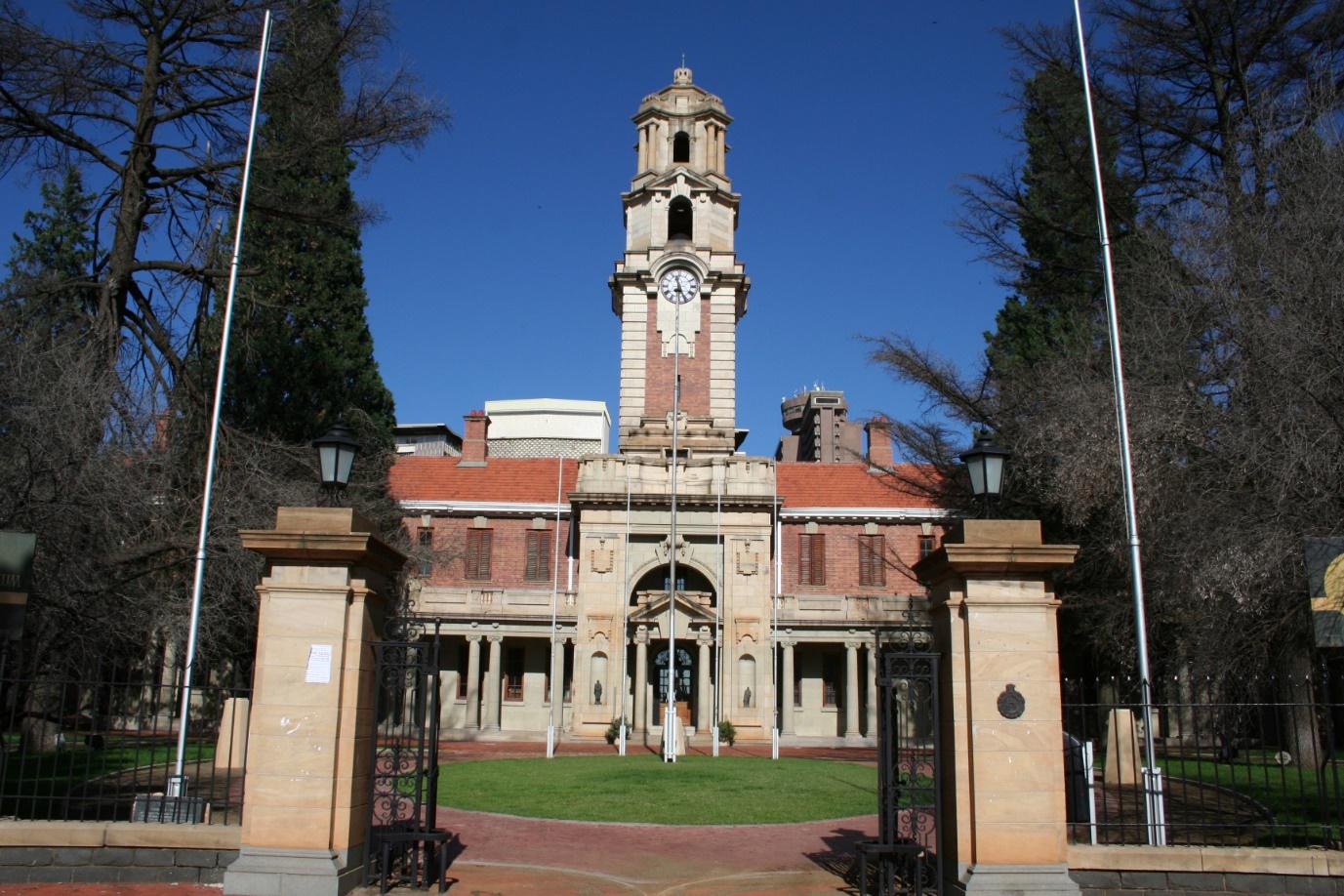
The National Afrikaans Literary Museum and Research Centre is a central archive for material and information on the history, development, and scope of literature, music, and drama in the Afrikaans language. The NALN was founded in 1973 by the Free State provincial government and is based in Bloemfontein, South Africa. NALN is located in the Old Free State Government Building. The building housed the various government departments of the Orange Free State government. The first story’s front facade was designed by Richard Wocke and the keystone was laid by President Brand on May 31, 1875. In 1895, the second story was built, designed by Johannes Egbertus Vixseboxse. The remainder of the building was designed by Sir Herbert Baker, an architect of the Union Buildings in Pretoria, and was completed in 1906.
On October 28, 1908, the original building was destroyed in a fire. From 1909 to 1911, it was largely restored based on Baker’s blueprint. Improvements were the work of the government architect F. Taylor. The tower was, among other things, narrower and 10.5 m higher than the original one, and was fitted with a rounded crown.
From 1877 to 1902, the Old Government Building was the headquarters of the Government of the Orange Free State. The Free State Volksraad met in the Third Council Chamber from 1877 to 1893. Afterwards, it remained the seat of the Government of the Orange River Colony, and in 1911 became the provincial headquarters of the Orange Free State. In 1972, the building was declared a national heritage site.
The Human Sciences Research Council began mounting exhibits in the building and using it as an archive for documents on language and literature in 1970. The document archive developed into the Literary Museum of Bloemfontein. On October 9, 1972, the Administrator of Free State, announced the establishment of the NALN. On March 24, 1973, the NALN was officially opened by Johannes Petrus van der Spuy, at the time Minister of National Education.
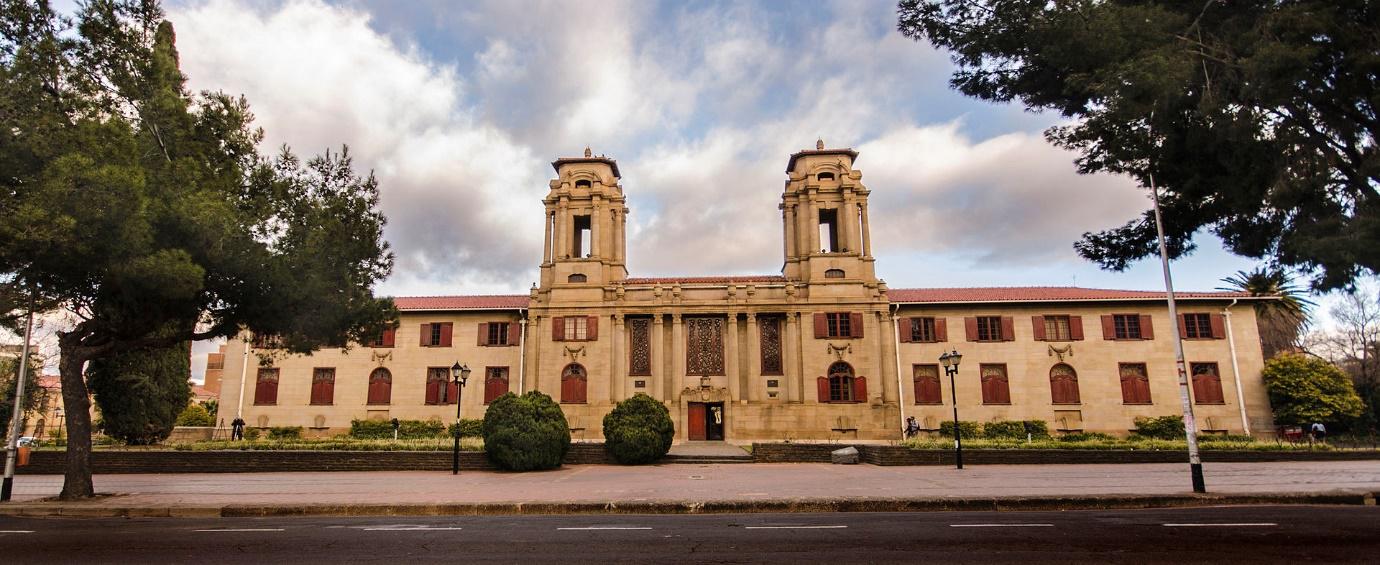
Bloemfontein City Hall is a building in Bloemfontein which houses the local city council. The building was completed in 1936 and burned by vandals in 2017. The building lies on President Brand Street downtown next to the Supreme Court of Appeal of South Africa and facing Hertzog Square. The building is a sandstone structure designed by Gordon Leith. The city hall has a large room, the council meeting room, behind its eastern entrance. The entrance on President Brand Street is designed symmetrically with two towers. Pillars give the east entrance neoclassical elements. Over the symmetrical entrance hang signs indicating Stadhuis and City Hall. Above these lie the former city coat of arms.
During the 1980s, new municipal offices were opened alongside the building. Even after municipal government changes in 2000 and its 2011 reclassification, the local government has continued to use the town hall.
On June 21, 2017, vandals set the building on fire. The fire was lit during a protest by the South African Municipal Workers’ Union held at the building earlier during the day. The municipal archives in the building were lost in the fire.
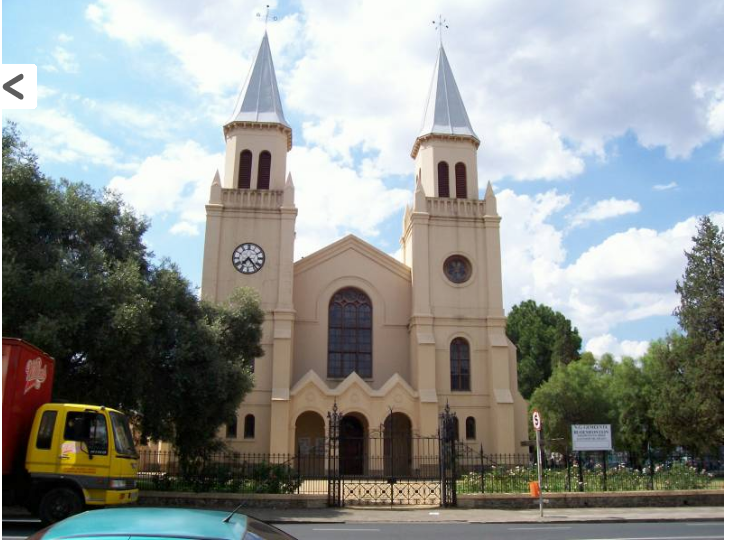
Established on 13 November 1848, The Dutch Reformed congregation, also known as the Tweetoring Kerk, held its services initially in the Raadsaal, a humble thatched building in St George’s Street. On 6 January 1849 Major Henry Warden, the British Resident Administrator, laid the foundation stone for a new church and, at the same time, presented a bell to the congregation.
The building was only completed on 29 May 1852. By 1862, it had grown too small for Bloemfontein’s needs and the construction of a new hall was proposed. The project was only undertaken in 1874 when architect AW Wocker was commissioned to design a church. The old building was demolished whilst services continued to be held in a warehouse, owned by the firm of GA Fitchardt, immediately across the road.
President Brand laid the foundation stone for the new church on 10 May 1878, and on 7 May 1880, the new building was consecrated. The structure was notable for its twin spires and is commonly known amongst citizens of Bloemfontein as the Tweetoring Kerk. Unfortunately in April 1935 the western spire, including its clock, collapsed. Following fears that the second spire could also fall, both towers were shortened at the height of the church roof and given shorter pointed steeples. Following extensive structural restoration, by the end of 1942, both spires had been restored to their former height. A subsequent fire in 1952, set by an arsonist, fortunately, caused little structural damage, and the building was declared a National Monument under old NMC legislation on 15 February 1963.
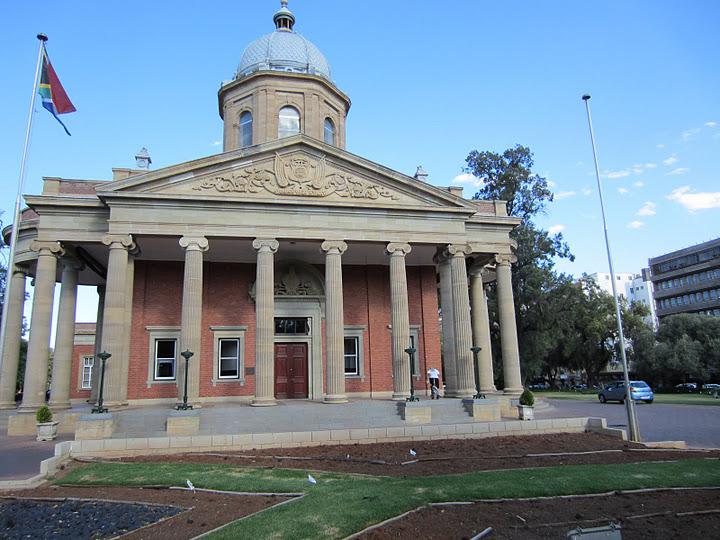
The Fourth Raadsaal is a historic building in Bloemfontein, South Africa, which serves as the meeting place of the Free State Provincial Legislature, the legislature of the Free State. It is located opposite the Supreme Court of Appeal in President Brand Street. In the early 1880s, it was resolved to build a new presidency office and chamber council. The designs for both buildings were awarded to Johannesburg-based Lennox Canning. The new presidency office was completed in 1886, yet work on the chamber council had not begun until 1889 by another Johannesburg-based architect, TR Robertson. President Francis William Reitz laid the foundation stone on 27 June 1890. Due to construction issues, another tender was awarded to JJ Kirkness. The new building was formally inaugurated on 5 June 1893 when the members walked from the old chamber to the new one.
In March 1900, British forces occupied Bloemfontein and the building became a military hospital. Most of the furnishing were acquired and are now in private homes. The Orange River Colony became the legitimate government in 1907. The colony had a two-chamber legislature consisting of a council and a legislative assembly. The lower council continued to meet in the Raadsaal, while a separate building facing Aliwal Street housed the upper house. In 1910, the Union of South Africa was formed and the Raadsaal housed the provincial council. The chamber and its rooms were occupied by the Appeal Court until its own premises was ultimately built in 1929. After the first non-racial elections in 1994, a decision was taken to house the newly-established provincial legislature in the building.
As one can see, just from the 5 historical buildings mentioned here, Bloemfontein is a city teeming with culture and is immensely rich in heritage. The buildings and museums reflect a historical journey and make Bloemfontein one of the most important cities to visit in the history of South Africa.
To view more Articles, please visit our Leads 2 Business Blog.
If you are interested in becoming one of our subscribers, please visit Leads 2 Business.
To view notes with screenshots on how to use our website, please visit Leads 2 Business Wiki.